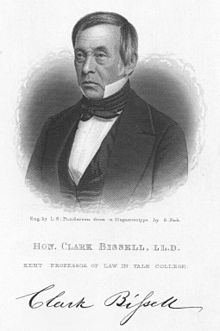Samuel Peck (1813–1879),[1][2] was an American 19th-century photographer, artist, businessperson, photo case manufacturer, and gallery owner. He was based in New Haven, Connecticut and produced daguerrotypes before moving into the manufacture of cases for daguerrotypes as, Samuel Peck & Co. (also written as S. Peck & Co. and Samuel Peck and Company).[3]
Samuel Peck | |
|---|---|
| Born | March 3, 1813 |
| Died | July 22, 1879 (aged 66) New Haven, Connecticut, U.S. |
| Resting place | Grove Street Cemetery |
| Nationality | American |
| Other names | Samuel H. Peck |
| Occupation(s) | photographer, photo case manufacturer, gallery owner |
| Employer | Samuel Peck & Co. |

Biography
editSamuel Peck & Co. was in operation in New Haven, from 1844 to 1857.[1][4] In 1844, Peck opened a photo gallery, where he worked as a daguerreotypist.[1] Starting in April 30, 1850, Peck had secured patents for his photo case designs.[5][6] Peck patented the first thermoplastic case, made from fine sawdust, shellac, and dye that were pressed and heated with steam to moldable forms. They are referred to as union cases and are collectable.[7][8]
Peck and his brother-in-law Halvor Halvorson produced daguerreotype cases molded from thermoplastic.[3] One of his cases lists Massachusetts.[4] One of their union case designs was inspired by a work of Danish sculptor Bertel Thorvaldsen (1770–1844).[9]
Daguerrotypes and their cases were supplanted by the less costly paper photograph industry and cartes de visite.[7]
Music Hall
editIn 1860 Peck built the Music Hall in New Haven; the building was later named the Grand Opera House, which burned down in a fire in 1915.[1][10] The Grand Opera House was used for social functions, political meetings, and religious meetings for 50 years and was important to the city of New Haven.[10]
Collections
editWork by Samuel Peck and Samuel Peck & Co. are in Harvard University's Houghton Library collection, including a daguerrotype portrait in one of Peck and Halvorsen's thermoplastic cases; as well as in the collection at the Smithsonian American Art Museum.[5][11] The New Haven Museum and Historical Society has an entire collection of Peck's daguerrotype cases.[12]
See also
editReferences
edit- ^ a b c d "Peck, Samuel, −1879". The Library of Congress, LC Linked Data Service. Retrieved 2021-11-04.
- ^ "Samuel Peck (1813–1879) buried in Grove Street Cemetery located in New Haven, CT". People Legacy. Retrieved 2021-11-04.
- ^ a b "Samuel Peck and Company". Princeton University Art Museum. Princeton University. Archived from the original on 2021-11-04.
- ^ a b "Daguerreotype, Samuel Peck & Co Case – 'Young Girl', Grape Vine, 9th Plate". rariora.com.
- ^ a b "Trade catalogs from Samuel Peck & Co". National Museum of American History. American History Museum Library, Smithsonian Libraries.
- ^ "The Grand Medal of Honor to Samuel Peck & Co.". The Photographic Times. Scoville Manufacturing Company. 1877. p. 4.
- ^ a b Berg, Paul K. (2006). "History of the Miniature Case". Luminous-Lint. Retrieved 2021-11-04.
- ^ "Collecting Early Photographica: Union Cases". Antiques & Auction News. July 30, 2010.
- ^ Henisch, B. A.; Henisch, H. K. (April 1, 1978). "Thorvaldsen daguerreotype cases". History of Photography. 2 (2): 135–140. doi:10.1080/03087298.1978.10442973 – via Taylor and Francis+NEJM.
- ^ a b "Grand Opera House, New Haven Oldest Connecticut Theatre, Completely Destroyed By Fire". Newspapers.com. The Bridgeport Times and Evening Farmer. 26 April 1915. p. 4. Retrieved 2021-11-04.
- ^ "Woman". Daguerreotypes at Harvard – CURIOSity Digital Collections. Houghton Library, Harvard University.
- ^ "Peck Daguerreotype Case Collection". New Haven Museum.